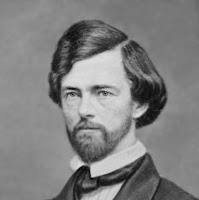 |
| South Idaho Sanitarium, now Idaho State Hospital South. J. H. Hawley photo. |
After the fire, male patients were kept temporarily at the Bingham county courthouse and females at the local Methodist Episcopal Church. The institution was rebuilt at a location a few miles further north.
In 1905, the legislature funded a second state hospital; it was built in Orofino. As views on mental health issues became more sophisticated, the terms “sanitarium” and “asylum” were dropped in favor of a simple “Idaho State Hospital South” and “ … North.”
Today, Idaho is still wrestling with the proper approach, or approaches to treating people with mental health problems. Clearly, sufferers who are a danger to themselves and to others require different methods and facilities from those with lesser problems. Unfortunately, there are no easy answers.
 |
| Official drawing for Patent No. 157,124. |
Homesteaders benefited first from the new product: It provided a way to protect fields from range cattle and sheep. In many jurisdictions, courts would not award damages for losses to stock unless the owner had tried to provide some sort of protection for his (or her) crops. An 1873 Idaho law said, in part, that farm fields “shall be enclosed with a good and lawful fence, sufficient to secure the crops therein from the encroachments of all kinds of domestic animals.”
Possible awards then hinged on the phrase “good and lawful fence.” A split rail fence met the criteria, but the materials were costly and difficult to obtain. In many areas, even wooden posts for stringing a wire fence had to be hauled from miles away. Still, posts and wire were far more affordable than anything available before.
Stockmen also quickly saw the advantages of fencing large expanses of range to keep it for themselves, and they had the capital to buy wire by the train car load. Thus, production of the new form jumped 60-fold a year after the patent was granted. Barbed wire fences brought their own problems, of course. The lore of the Old West is replete with stories of the fence cutters and gun-handy cowboys hired to patrol the wires.
| References: [Brit], [Hawley], [Illust-State] |
| Joseph M. McFadden, “Monopoly in Barbed Wire: The Formation of the American Steel and Wire Company,” Business History Review, Vol. LII. No. 4 (Winter, 1978). |
| J. Orin Oliphant, On the Cattle Ranges of the Oregon Country, University of Washington Press, Seattle (1968). |









